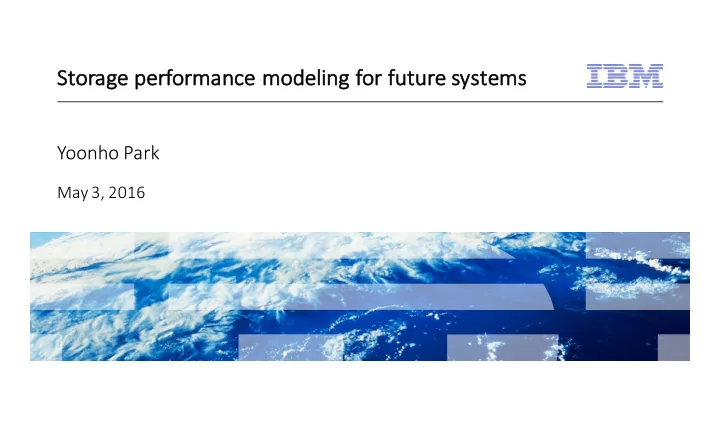

St Storage performance modeling for future systems Yoonho Park May 3, 2016
Agenda • Storage challenges • Burst buffer • APEX workflows document • Machines analyzed • LANL workflows performance modeling • Workflow time distribution • CORAL burst buffer • Ongoing work 2
Storage challenges • Current parallel file systems are unable to consistently deliver an adequate fraction of aggregate disk bandwidth • I/O patterns that lead to irregularity and unpredictability • Multiple processes writing to a shared file (N:1) • Bursty I/O (e.g. checkpointing) vs Underutilization (very low baseline) • Increased capacity and bandwidth requirements for future systems (exascale) 3
Burst buffer • Absorbs bursty I/O patterns via higher • Use cases bandwidth and lower latency (compared to • Checkpoint and resilience parallel file system) • Analysis, post-processing, and visualization • Allows parallel file system to be sized • Caching and performance optimization for capacity (not overdesigned) • Extend memory capacity (e.g. large problems) • HDD capacity grows faster than bandwidth • SSD still is more expensive than disk for capacity Registers Fast (bandwidth and latency) kB Small (capacity) Expensive Cache MB Memory Memory GB Slow Burst buffer Large Disk Cheap PB Disk 4 ...
APEX workflows document • Specification of large-scale scientific • The information obtained from the simulation and data-intensive document and discussed throughout workflows the meetings with the APEX labs has been used to: • Workflow phases • Model performance improvement • Campaign duration provided by having burst buffer for a • Workload percentage variety of use cases • Wall time (pipeline duration) • Design and enhance future storage • Resources allocation (e.g. CPU cores and hierarchy architectures and underlying total memory for routine vs hero runs) components (e.g. OS support, • Anticipated increase factors (problem size transparency, and usability) and number of pipelines) by 2020 • I/O details (e.g. files accessed) • Amount of data retained (temporary, campaign, and forever) 5
Machines analyzed • Trinity burst buffer to main memory ratio: 1.75 X Cielo Edison Trinity* • Application efficiency estimated to be 88% Nodes 8,944 5,576 9,436 (12% of checkpoint overhead) [3] Total cores 143,104 133,824 301,952 • Trinity burst buffer nodes: Cores per node 16 24 32 Total memory (TB) 286 357 1,208 Memory per node (GB) 32 64 128 Bandwidth per node (GB/s) 85 103 137 PFS capacity (TB) 7,600 7,560 82,000 BB capacity (TB) - - 3,700 PFS bandwidth (TB/s) 0.16 0.17 1.45 BB bandwidth (TB/s) - - 3.30 * CPU only (no accelerators) 6 Trinity data obtained from [4]
LANL workflows performance modeling • Performance modeling (predictions) based on anticipated increased problem sizes for 2020 • Around 2x I/O performance improvement • Around 20x improvement over Cielo parallel from parallel file system to burst buffer file system (for the same checkpoint interval) Graph also shows results for half BB bandwidth Essential to maintain checkpointing feasible • • Workflow: LANL LAP Workflow: LANL Silverton 70.00% 200.00% 180.00% 60.00% 160.00% Checkpoint overhead Checkpoint overhead 50.00% 140.00% 120.00% 40.00% 100.00% 30.00% 80.00% 60.00% 20.00% 40.00% 10.00% 20.00% 0.00% 0.00% 0.00 1.00 2.00 3.00 4.00 0.00 1.00 2.00 3.00 4.00 7 Checkpoint interval (h) Checkpoint interval (h)
Workflow time distribution • Drastic performance improvement for checkpointing and other I/O operations Predictions based on checkpoint interval of 1 hour and current problem size (hero run, without increasing factors) Workflow: LANL LAP Workflow: LANL Silverton hours percentage hours percentage 8
CORAL burst buffer • Support rapid checkpoint/restart to • Deterministic performance reduce the parallel file system • Burst buffer bandwidth variation should performance requirements by an not exceed 5% and must not degrade over a period of 5 years order of magnitude (bandwidth) • Reliability of the burst buffer is a • Asynchronous drain checkpoint data function of node electronics and SSD to CORAL parallel file system drive • Per-node design to maximize • MTTF of more than 2 million hours throughput and minimize latency to • Mean time to data loss solely based on utilize the burst buffer for SSD is designed to be at least 434 hours checkpointing (4,608 nodes) • Burst buffer is non-volatile, data can still be retrieved up to three months after node failure or power outage 9
Ongoing work • Workflows specification is also being used to model other performance characteristics (e.g. processing, memory, and networking) • Modeling performance, cost, and other aspects of different burst buffer architectures (e.g. per-node vs specialized burst buffer nodes) 10
Recommend
More recommend